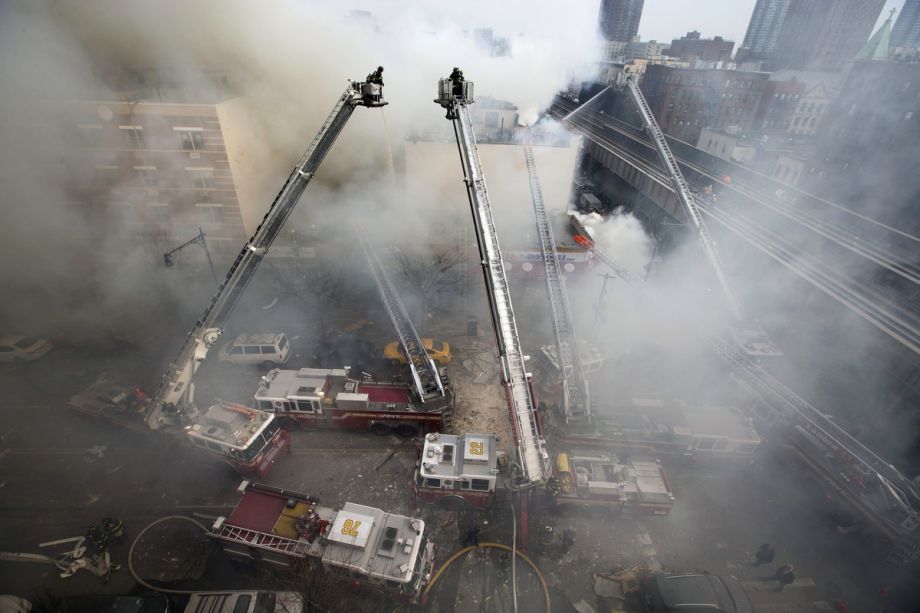On Wednesday morning, two tenements in Manhattan’s East Harlem neighborhood exploded in a fiery blast that killed at least seven people and injured dozens more. Less than 20 minutes before the ground-shaking explosion, a call had been placed to Consolidated Edison, a local utility company, about the strong smell of gas, which had started to a lesser degree the night before.
The exact cause of the explosion is not yet known — it could have been aging natural gas pipes, or it could have been work going on in one of the buildings — but the incident has focused attention on gas infrastructure in cities.
The Center for an Urban Future, a New York-based think tank that just one day prior to the incident released a report on the state of the city’s infrastructure, pegged the total repair bill at $47 billion. Adam Forman, the report’s author, wrote on Tuesday that New York tallied 5,835 reported gas leaks in 2013 alone. He put the average age of the city’s 6,300 miles of gas mains at 56 years, and noted that 2 percent of the gas that Con Ed sends to customers is lost through leakage — leakage that can turn deadly, as was the case on Wednesday.
As for what may have caused the explosion, a member of the National Transportation Safety Board, the federal agency that’s investigating the incident, told the media on Wednesday night, “We’ve have a longstanding concern about cast-iron pipe, and we are certainly looking at that.” Beneath Park Avenue, where the explosion occurred, the cast-iron gas pipeline is 127 years old. Sixty percent of Con Ed’s gas mains are made of cast-iron pipe, according to the Center for an Urban Future.
Cast-iron pipes became popular in the late 19th century and were used extensively until the middle of the 20th, when modern plastic piping appeared. “Since these [cast- and wrought-iron] pipelines transported wet, manufactured gas,” the U.S. Department of Transportation’s Pipeline and Hazardous Materials Safety Administration has written, “the packing material absorbed moisture and generally did not leak.” But “as dry, natural gas began supplanting manufactured gas use in the mid-20th century, the packing material sealing the joints dried out, causing leaks.”
While only 2.6 percent of gas distribution mains are made of cast-iron pipes, the administration says that 11 percent of safety incidents involve the old piping. Accidents involving cast- or wrought-iron pipes are more likely to cause injuries or fatalities than those involving newer pipes — more than 40 percent more likely in the case of mains, and more than twice as likely with so-called “services,” which lead to individual buildings.
Cities appear to have much older piping than other areas. While about half of New York City’s gas mains are made of cast-iron, that number stands at only 9.2 percent for New York State. States with the highest percentage of outdated gas main mileage — Rhode Island, Connecticut, Massachusetts and New Jersey, as well as Washington, D.C. — are among the country’s oldest and most urbanized. Over the past few years, there have been three deadly incidents involving cast-iron gas mains, all in areas of cities (Austin, Philadelphia and Allentown, Pa.) where gas mains were laid in 1950 or earlier.
Services have been replaced more aggressively than mains. Only 24 percent of Con Ed’s service milage in New York City consists of unprotected steel or cast-iron. But this number still far exceeds the state average of 0.3 percent.
Even before the deadly explosion, the Center for an Urban Future wrote that “a more aggressive replacement schedule may be warranted” than Con Ed’s current plans of 30 miles of cast-iron pipe each year. (Replacing a mile of main in New York City costs anywhere from $2.2 million to $8 million.) If a cast-iron main turns out to be the culprit, expect the city and utilities to embrace this recommendation sooner rather than later.
In Washington, D.C., where 35 percent of mains are made of cast- and wrought-iron pipes, researchers found nearly 6,000 natural gas leaks in a study published earlier this year. The team tested 19 of the leaks and found potentially explosive concentrations of methane at 12 of them. “The really surprising thing,” one researcher told NPR, is that “when we went back four months later after calling in these leaks, nine of the 12 hadn’t been fixed. And that really shocked me.”
While one New York City councilmember told Capital New York that the state or the feds would have to shoulder the cost of replacing gas mains, the reality is that utilities, most of which are private, maintain this infrastructure. They are, however, heavily regulated public utilities, with rates set by state utility commissions — rates that politicians are eager to keep down. On December 31, New York Gov. Andrew Cuomo announced with much fanfare that the state’s Public Service Commission would deny Con Ed’s request to hike gas rates by 2.5 percent, and would instead leave rates constant until 2016. Whether that will leave Con Ed with enough money to accelerate gas main replacement remains to be seen.
The Works is made possible with the support of the Surdna Foundation.
Stephen J. Smith is a reporter based in New York. He has written about transportation, infrastructure and real estate for a variety of publications including New York Yimby, where he is currently an editor, Next City, City Lab and the New York Observer.







_600_350_80_s_c1.jpg)









